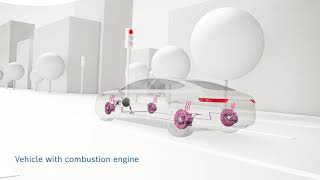EN | Bosch regenerative braking
EN | Bosch regenerative braking
 Regenerative braking is the recovery of kinetic energy during braking. In vehicles with a combution engine, a majority of the kinetic energy is converted during friction braking into heat and emitted unused into the environment. Hybrid or electric vehicles can use the electric motor to recuperate at least a portion of the kinetic energy for re-use.
Regenerative braking is the recovery of kinetic energy during braking. In vehicles with a combution engine, a majority of the kinetic energy is converted during friction braking into heat and emitted unused into the environment. Hybrid or electric vehicles can use the electric motor to recuperate at least a portion of the kinetic energy for re-use.
Overall, regenerative braking makes far less use of friction braking. This leads to less wear and a significant reduction in brake dust. Regenerative braking systems from Bosch for increased ranges, lower fuel consumption, and an improved CO2 balance.
More information: https://www.bosch-mobility-solutions.com/en/solutions/driving-safety/regenerative-braking-systems/
This video in German: https://youtu.be/x_Z2db5Ihd8

I miss my 1997 Toyota prius, has regenerative braking as well.
*super* video
why don’t make it while driving there’s another generator mode.?so we could recharge even more
Is possible a motor generator all time during driving? or electromotor generator with high temperature?..
I would really like to know the efficiency % of this system, that would answer the question people always ask: What is the most efficient way of driving: Zero regeneration with coasting or using high regeneration.
Thank you, but this seems to be another ultra expensive part or system that will break right after the guarantee period will be over.
(Ever heard about "design-to-cost", DTC, by automotive manufacturers and supliers?)
Very helpful video
thanks for making knowledgeable video
this is my favourite thing about electric and hybrid vehicles
Question is, can friction breaking supply a heat, that helps the battery recover energy better. Tires should also give off draft for well placed mini turbines. Additionally, Some sort of friction based element should either contact road just to spin and make heat, be placed somewhere near hydraulics to glom energy from tires themselves spinning. Possibly mini treadmill by tire axel. It’s going to reclaim more friction energy, which is only needed at steady, low amount, then drag added to car motion. It only needs friction heat of about a minute or less of driving….until it gets too cool again…
1:24, if your engineering team has time, when the brake pedal is being pressed lightly, as the vehicle stops, at 0.1m/s or something, release brake pressure so the car does not lurch like that so the halt is very smooth. This will attract more luxury brands and accrue more interest from professional drivers.
This system works for field coil, Permanent Magnet motor and reluctance motors or just one type?
Can we use regenerative braking technology to harvest electricity from wind turbines?
Physics is awesome
Sir why ev and fhev ignores the rear wheel?? Kindly put a alternator in rear wheel and which can easily run by wheels using a differential where mechanical advantage can be increased… now a days road condition are better than before above 40kmph the vehicle easily generates power from rear wheel. if we get almost 20% power then the average will also increase… its my request to your r&d team… cause we have no facility for this research…..😆
Toyota is the pioneer of the Hybrid driving